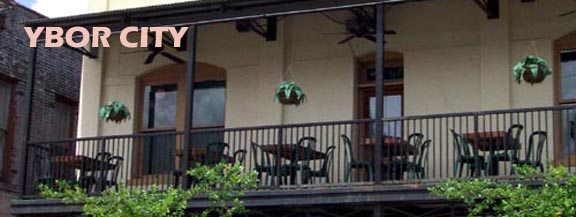
YBOR CITY
HISTORIC DISTRICT (Tampa)
THE LATIN QUARTER TURNS FROM CIGARS TO ENTERTAINMENT
Tampa's historic Latin Quarter, YBOR
CITY, covers two hundred acres one
mile northeast of downtown Tampa.
Despite the decline of the cigar industry after 1920 and vast urban renewal
destruction in the 1960's, there's enough of the buildings and atmosphere of
Vicente Martinez Ybor's multiethnic manufacturing
town, the first in the South, to interest visitors of all ages. I taught in Ybor City for 35 years and can report that most crime activities take place very late at night with people who have spent too much time drinking and flashing money. You will find PARKING SPACES behind many Seventh Avenue stores and at the big garages two blocks south of Ybor Centro and one block west of Ybor Square, once the land's largest cigar factory, then a shopping mall, and now owned by the Church of Scientology..
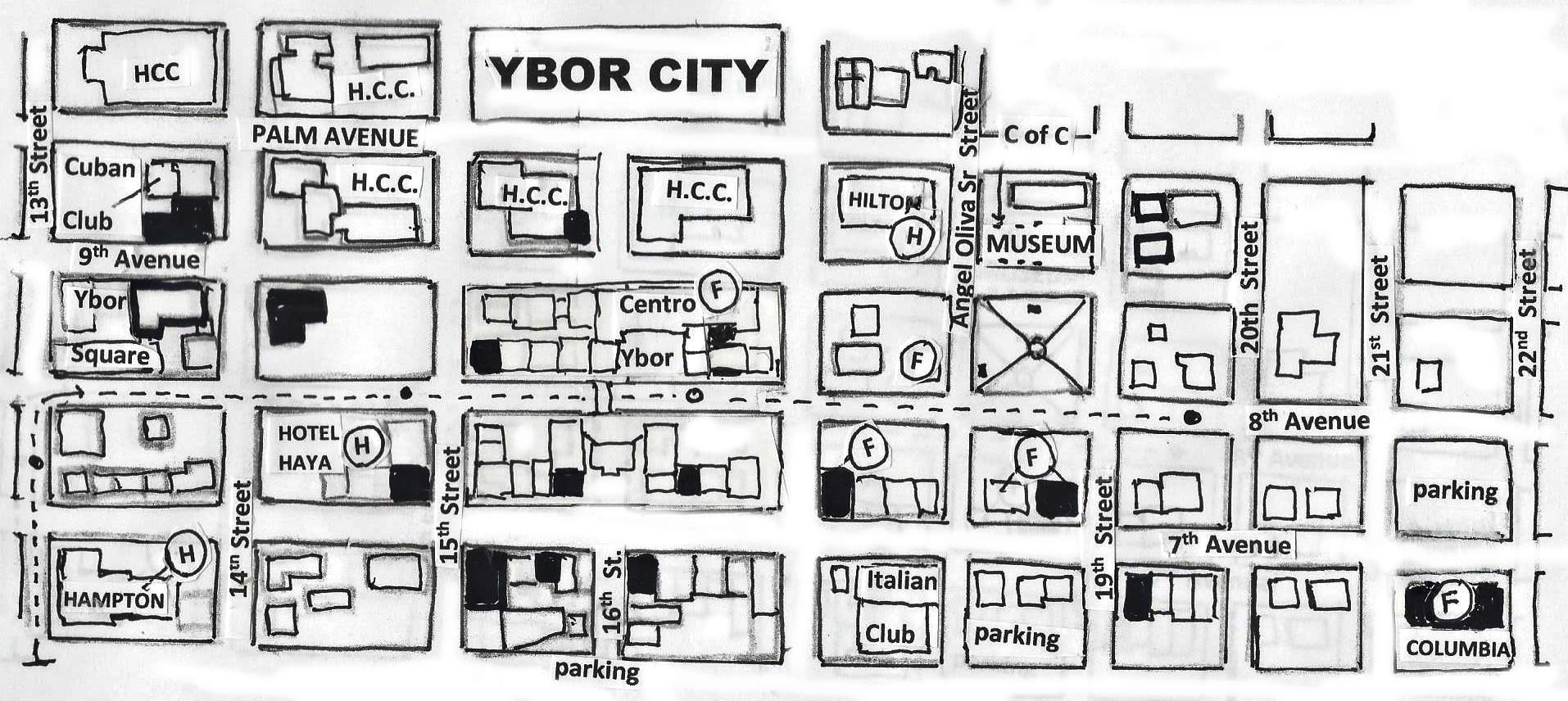
In recent years there has been a tremendous
revival of development along Ybor
City's colorful main artery, SEVENTH AVENUE, as new restaurants,
stores, nightclubs, and art galleries have returned Ybor City
to its original status as the nighttime entertainment center of the Florida
West Coast. I taught history at the Ybor Campus of Hillsborough Community College when it opened and selected a classroom which looked out at three historic structures I put on the State List when I worked as project historian for Florida.
HOW TO GET THERE: If
traveling west of I-4 to Tampa,
take Exit 1 on Interstate 4 and cross the first traffic light at 22nd Street, then turn left (southward)
on 21st Street. If traveling east on I-4,
take Exit 1 and turn right on 21st Street. Seventh
Avenue is sixth blocks south of the Interstate.
THE HISTORIC TOUR: Limited parking is available along Seventh
Avenue while large off-street public parking is noted on the Ybor City Map. Visitors may wish to drive this tour
selecting places to visit and stop only when interested. Parking garages are
on 9th Avenue & 13th Street and at 6th Avenue and 15th Street. Don't be shocked to see roosters running across less busy streets in Ybor for they are legal here. And don't bother them or they get mad.
If you
are at 7th Avenue and 21st,
you see the:
(1) COLUMBIA RESTAURANT (1905), (813-248-4961)
2117 7th Avenue, Florida's
oldest restaurant, and with 1200 seats spread across a dozen rooms, one of the
world's largest. Founded by Casimire Hernandez after
the song :"Columbia,
Gem of the Ocean", the restaurant merits a visit just to see the 1936 Don Quizote Room with its scenes by Sergio de Meza or the
two-storied courtyard. The original cafe started on the 22nd Street corner and the restaurant
expanded
TURN RIGHT ON 7TH AVENUE. If its morning, you might start to smell Cuban
coffee being made at Naviera Coffee Mills in the
block that contains on the right the: (2) COLUMBIA BANK (1918), 2018 7th Avenue, founded by John Grimali. A plaque on the sidewalk, one of many walkers will
note on this route, honors Tampa's Italian population, most of whom were
Sicilians who came to Florida originally for farm work, but who became cigar
makers and merchants
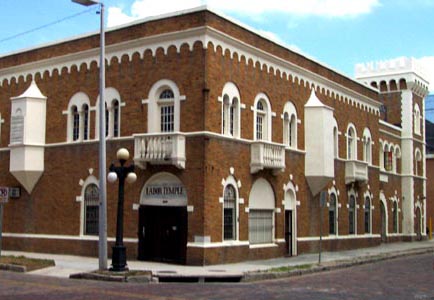
On the next block on the left at 1901 7th Avenue, is the (3) SCOZZARI
BUILDING (1893), an early brick structure designed by Pietra and Jose Scozzari It
housed the original La Tropicana Restaurant and the Bank of Ybor
City. Across the street is the new (4) LA TROPICANA, 1822 7th Avenue,(813-247-4041) notable as an important Tampa political hangout and Cuban sandwiches. Next door is the long-operatingCARMINES (Italian( (813-248-3834)..
More blue collar was the (5) SILVER RING SANDWICH SHOP;
atwas at 1831 7th Avenue, a culinary landmark for
the Cuban sandwich's popularity across Tampa..

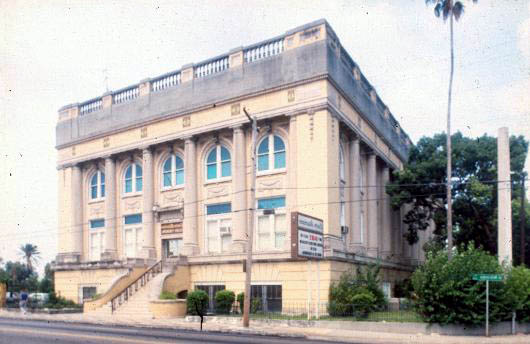
TURN
RIGHT ON 18TH STREET AND GO TWO BLOCKS past Centennial
Plaza and the Ybor City
Farmers Market. You may wish to stop to examine the wonderful 1992 statue
honoring Ybor
City's immigrant
population. Look for the statue of my friend TONY PIZZO, the man responsible for creating the first
architectural review area in Florida and
saving Ybor
City in the 1940s and
1950s.On the northern side of the
Plaza is the:
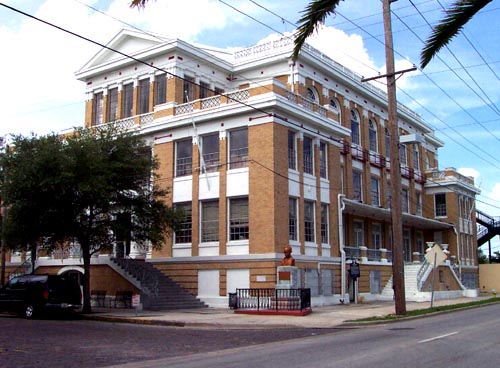
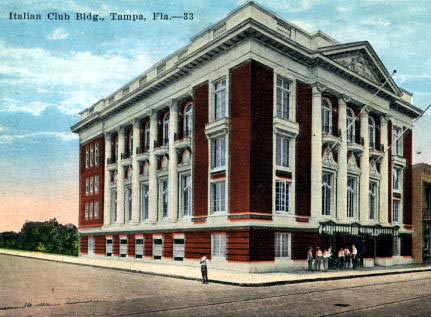
(6) YBOR CITY STATE MUSEUM,
1818 9th Avenue, housed in the 1926 Ferlita Bakery.
The admission price is small but there is more to see with the plaza and
historic cigar workers cottages.
RETURN TO SEVENTH AVENUE BY 18th STREET and turn right, just before the:
(7) L'UNIONE ITALIANA (1917), 1725 7th Avenue, the three-story Italian
Renaissance clubhouse started in 1897. Like many ethnic clubs, the basement
housed the canteen, the middle floors had offices and
a library, while the top floor has a ballroom. You might recognize the edifice
as the hotel in the movie Long Gone.
Across the street is a diversity of
businesses including (8) EL SOL CIGARS, 1728 7th Avenue, oldest of Ybor
City's cigar stores.If it is closed, look for the cigar maker at
the shop next to the Columbia.
The 1600 block contains several of Ybor
City's older structures:
The (9) BALDOMERO F. MARCOS BUILDING (1912), 1610 7th Avenue, designed by Kenneth
Kennard, featured the area's first light well system. Across the street at 1602 7th Avenue is the (10) GAVINO GUTIERREZ
BUILDING (1904), built by the
Spanish-born engineer who convinced Vicente Martinez Ybor
to bring the cigar industry to Tampa from Key West. The Dixie Hotel
was once upstairs and Buffalo Bill's cousin ran the Pathe
Theater downstairs.
On the south side of the 1500 block is
another Kennard building, the (11) FRANCISCO MAYO
BUILDING
(1912), 1517 7th Avenue,
constructed for cigar manufacturers Serafin Sanchez
and Ignacio Haya to house the Spanish Theater.
Across the street is the huge (12) CENTRO
ESPANOL (1912), 1526 7th
Avenue, saved from destruction by the State of Florida. The Spanish
club is now part of the giant CENTRO YBOR entertainment complex which has
a comedy club, restaurants, and a Gameworks over on 9th Avenue.The club canteen is now a store, but the upstairs
ballroom houses a interesting steak restaurant and the theatre as a comedy club. Tour
the club to get the feel of its origins as a clubhouse for the Spanish community of the Cigar Era.
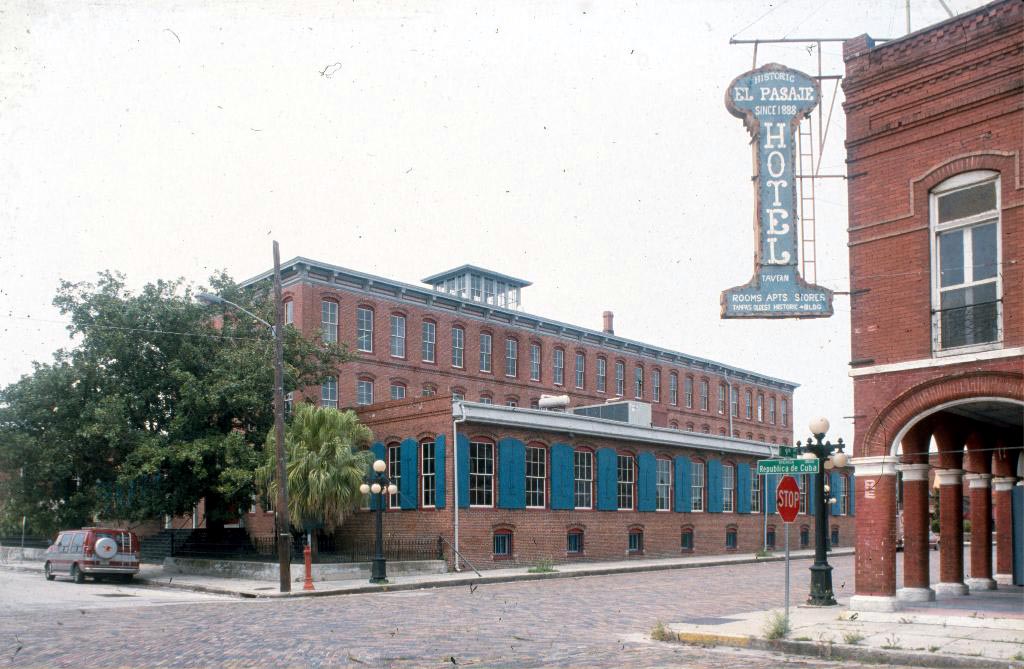
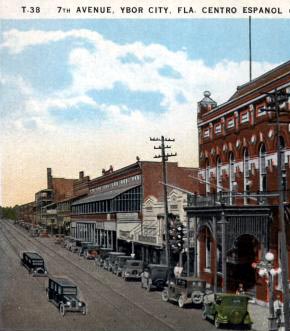
At the end of the block on the left is the
(13) RITZ THEATER (1928), 1502 7th Avenue, once a movie house with
an interior resembling a Spanish plaza. A popular showplace now houses this
spot where once stood Ybor City's
first factory, the 1886 Sanchez & Haya Factory.
BEFORE TURNING RIGHT ON 15TH STREET, admire the corner tower of: (14) LAS NOVEDADEZ
RESTAURANT (building) (1892), 1430 7th Avenue, site of a long-time
restaurant, where during the Spanish-American War, Teddy Roosevelt's Rough
Riders rode in to eat on their horses. It is said the Cuba Libre
(rum and Coke) was created here.
GO
UP 15TH STREET AND TURN RIGHT ON 8TH AVENUE, in front of the brick King-Greco Hardware building
where three-time Tampa
mayor Dick Greco lived. Next door is the: (15) LLANO BUILDING
(1903), 1514 8th Avenue, built by Antonio de Rio
and still maintaining its iron and wood balcony. Tony Pizzo,
Ybor City's favorite historian and author of Tampa Town,
started his business career here.
The building next to the hardware store
once housed the Creatures of Delight, T. Oliver Kopian's
infamous creatures made of special plastic into book bags and playthings. Most
of Ybor's Seventh Avenue
buildings have been converted into nightclubs and restaurants, but many side
streets still house artisans and unusual shops.
TURN
LEFT ON 17th STREET AND THEN LEFT ON 9TH AVENUE. The unusual
structure on your left is the: (16) YBOR CITY LABOR TEMPLE (1930), a castle-like
meeting place for labor unions, now a restaurant/club.This place once was a site of several muders, rather interesting since it is next to HCC Police Academy and Fire Science
Center.
CROSS 15TH STREET alongside the Ybor City
Campus of Hillsborough Community College where yours truly opened his history "shop" in
1974. You may wish to park in the Ybor Square
parking center one block further on the left for this corner has several notable
sites. On your right is the:
(17) EL PASAJE (CHEROKEE CLUB)
(1896), 1318 9th Avenue, the arcaded Italian Renaissance men's club set up by Ybor's business partner Edward Manrara.
The second floor ballroom was the spot where politicians for fifty years
announced their candidacy for Governor. The last Mayor of West Tampa turned
over the keys to that Latin town to the City of Tampa.
Next door is the (18) CUBAN CLUB
(1916), 2010 (14th) Avenida Republica
de Cuba, a four-story edifice. This was the site of much revolutionary activity
in the 1890's.
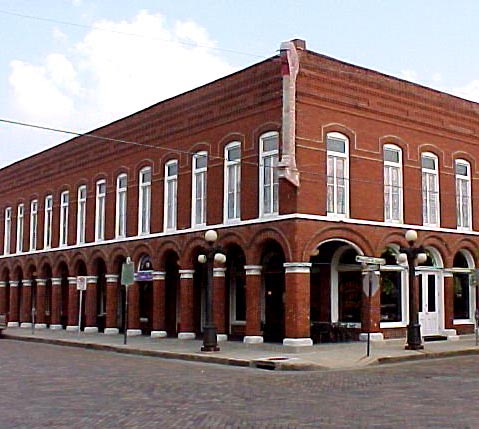
At 1915 14th Avenue is the hidden brick-made
(19) YBOR CITY LAND & DEVELOPMENT BUILDING
(1893), once headquarters of Edward Manrara's real
estate empire and later the Gonzalez Clinic where many important Tampans were born.
Once it was a stylish bed and breakfast and as an office building I am tempted to at least enter the
lobby to see what it looks like.
Across the street is Ybor City's
most famous structure, the massive (20) YBOR FACTORY (YBOR SQUARE) (1886), the city's
oldest brick building and once the largest cigar factory in the United States.
On the East side is the historic Jose Marti steps where Cuban Revolutionary
leader promoted money and manpower for Cuban independence. Just inside these
doors on the left was Vicenete Martinez Ybor's first Ybor City
office. It is now owned by the Church of Scientology and all the stores and restaurants are gone.
You can still walk around the massive building.
The complex consists of three buildings: the
(20A) YBOR FACTORY, a three-story brick building now
housing training classrooms.. The (20B) STEMMERY BUILDING
(1902), on the southeast corner of the block, was the Stachelberg
Cigar factory.
The (20C) WAREHOUSE BUILDING
(1920) once contained the popular Spaghetti Warehouse. Note the railroad track
remains in the courtyard and the roof top cupola, perfect for watching the
status of tobacco ships in the nearby Port of Tampa.
To the south of Ybor
Square is (21) JOSE MARTI PARK, 1303 8th Avenue, containing a
life-size statue of Jose Marti, is located on the site of the home of famous
Afro-Cuban patriot Paulina Pedrosa,
Marti's residence in Ybor City. In the backyard here,
Marti forgave the Spanish spy who tried to poison him. Appropriately at nearby
1226 7th Avenue, is the (22) UNION MARTI-MACEO, the club formed
in the 1890's to serve Ybor City's Afro-Cuban
population.
Ybor City
historic districts extends four blocks west on Palm Avenue to take in the CENTRO ASTURIANO CLUB, with its gtreat stage and basement cafe, and the GERMAN-AMERICAN CLUB BUILDING,
now a city center.










